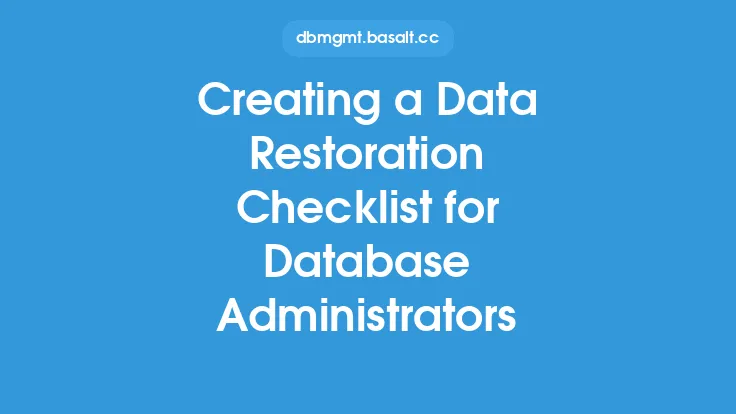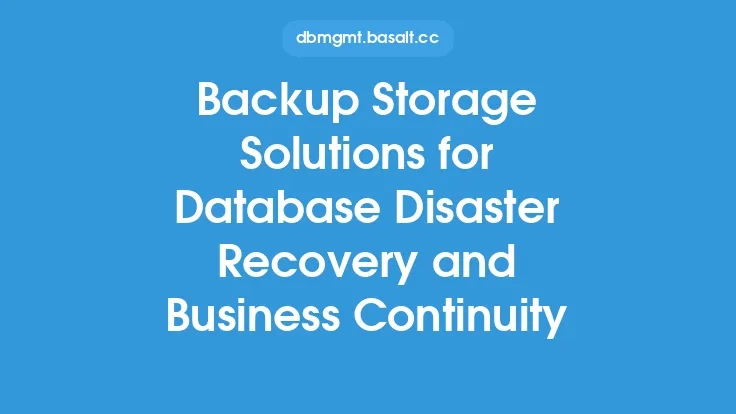In today's digital age, data is the lifeblood of any business. It is the foundation upon which companies build their operations, make informed decisions, and drive growth. However, with the increasing reliance on data comes the risk of data loss, which can have devastating consequences for businesses. This is where data restoration comes into play, serving as a critical component of business continuity. Data restoration refers to the process of recovering and restoring data that has been lost, corrupted, or deleted, ensuring that businesses can quickly resume operations and minimize downtime.
Introduction to Data Restoration
Data restoration is a complex process that involves a series of steps, including data backup, storage, and recovery. It requires a deep understanding of data management, storage systems, and recovery techniques. The goal of data restoration is to restore data to a consistent and usable state, ensuring that businesses can access and utilize their data without interruption. This is particularly important for businesses that rely heavily on data-driven decision-making, such as financial institutions, healthcare organizations, and e-commerce companies.
The Importance of Data Restoration for Business Continuity
Data restoration is crucial for business continuity because it enables companies to quickly recover from data loss or corruption, minimizing the impact on their operations. Without a robust data restoration process in place, businesses risk facing significant downtime, revenue loss, and reputational damage. In fact, according to a study by IT Brand Pulse, the average cost of downtime for a business is around $5,600 per minute, highlighting the importance of having a reliable data restoration process in place. Furthermore, data restoration helps businesses maintain regulatory compliance, protect sensitive customer information, and ensure the integrity of their data.
Types of Data Restoration
There are several types of data restoration, including file-level restoration, volume-level restoration, and bare-metal restoration. File-level restoration involves recovering individual files or folders, while volume-level restoration involves recovering entire volumes or disk images. Bare-metal restoration, on the other hand, involves recovering an entire system, including the operating system, applications, and data. Each type of restoration has its own set of challenges and requirements, and businesses must choose the approach that best fits their needs.
Data Restoration Techniques
There are several data restoration techniques that businesses can use, including backup and restore, replication, and snapshots. Backup and restore involves creating regular backups of data and storing them in a secure location, such as an external hard drive or cloud storage service. Replication involves creating duplicate copies of data in real-time, ensuring that data is always available and up-to-date. Snapshots, on the other hand, involve creating a point-in-time copy of data, allowing businesses to quickly recover from data loss or corruption.
Best Practices for Data Restoration
To ensure effective data restoration, businesses must follow best practices, such as regularly testing backups, using multiple backup methods, and storing backups in a secure location. Additionally, businesses should implement a robust data management strategy, including data classification, data retention, and data disposal. This helps ensure that data is properly organized, stored, and protected, making it easier to restore in the event of data loss or corruption.
Data Restoration Tools and Technologies
There are several data restoration tools and technologies available, including backup software, storage systems, and cloud services. Backup software, such as Veritas NetBackup and Commvault, provides businesses with a comprehensive backup and restore solution, including features such as data deduplication, compression, and encryption. Storage systems, such as disk arrays and tape libraries, provide businesses with a secure and reliable way to store backups. Cloud services, such as Amazon S3 and Microsoft Azure, provide businesses with a scalable and on-demand backup and restore solution.
Challenges and Limitations of Data Restoration
Despite the importance of data restoration, there are several challenges and limitations that businesses must be aware of. These include data corruption, backup failures, and restore errors. Data corruption can occur due to hardware or software failures, while backup failures can occur due to inadequate backup procedures or storage limitations. Restore errors, on the other hand, can occur due to incorrect restore procedures or incompatible hardware or software. To overcome these challenges, businesses must implement a robust data restoration process, including regular testing, validation, and verification.
Conclusion
In conclusion, data restoration is a critical component of business continuity, enabling companies to quickly recover from data loss or corruption and minimize downtime. By understanding the importance of data restoration, types of data restoration, data restoration techniques, and best practices, businesses can ensure that their data is properly protected and restored in the event of a disaster. Additionally, by leveraging data restoration tools and technologies, businesses can simplify the restoration process, reduce costs, and improve overall efficiency. Ultimately, a robust data restoration process is essential for businesses that rely heavily on data-driven decision-making, and it is crucial that companies prioritize data restoration as part of their overall business continuity strategy.





